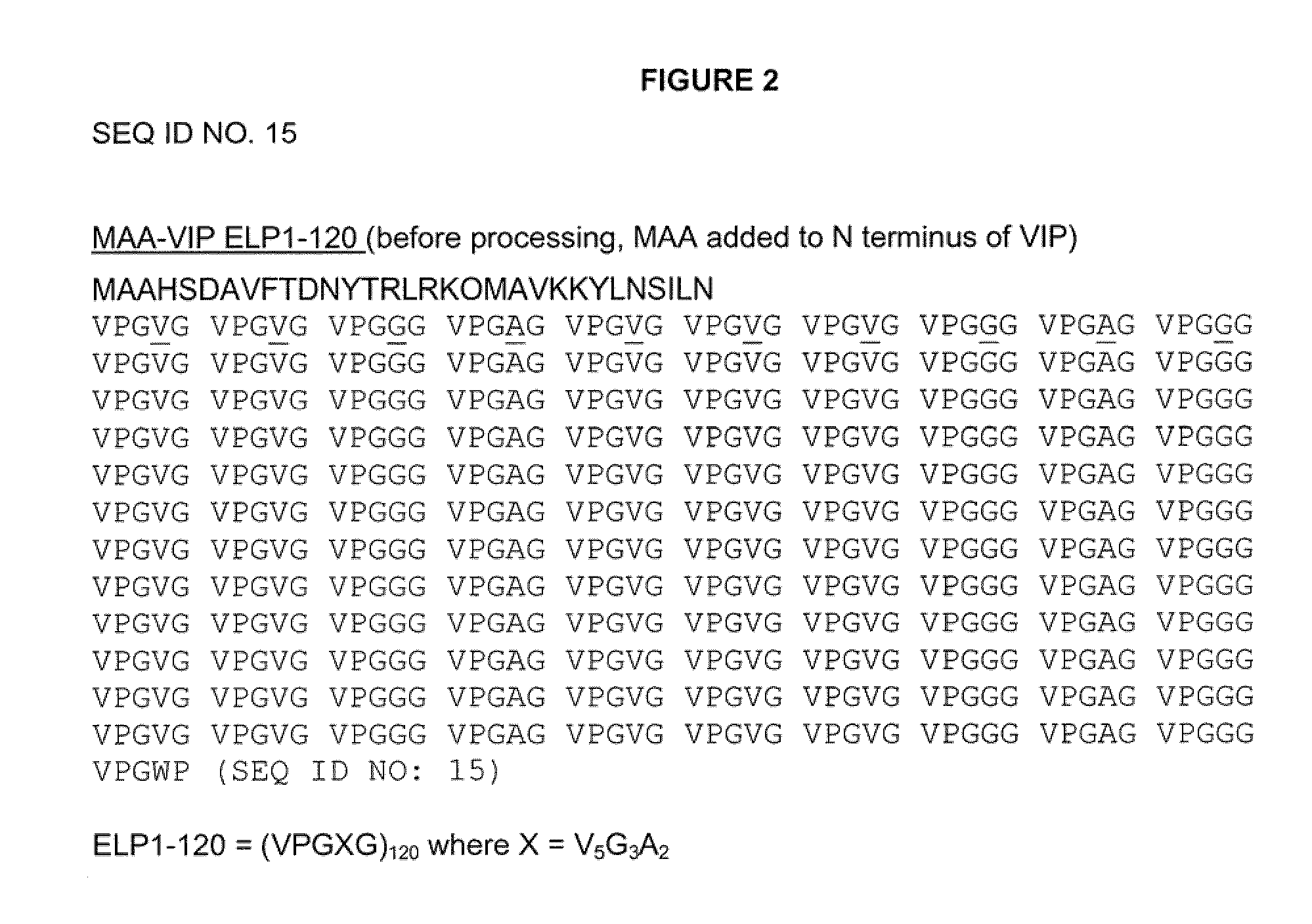Modified vasoactive intestinal peptides
- Summary
- Abstract
- Description
- Claims
- Application Information
AI Technical Summary
Benefits of technology
Problems solved by technology
Method used
Image
Examples
example 1
Cloning of VIP-ELP Constructs
[0126]The DNA sequence for the VIP peptide was as described in Simoncsits et al. (Synthesis cloning and expression in Escherichia coli of artificial genes coding biologically active elongated precursors of the vasoactive intestinal polypeptide. Eur. J. Biochem, 1988, 178(2):343-350, which is herein incorporated by reference in its entirety for all purposes), except that residue 17 was the native methionine and did not have either of the described C-terminal extensions (See SEQ ID NO. 16).
[0127]Two initial variants were made, one with a methionine at the N-terminus, due to the required ATG start codon, (PB1046, SEQ ID NO. 17) and one with the tripeptide MAA at the N-terminus (PB1047, SEQ ID 18). The methionine on PB1046 would normally be removed by methionine aminopeptidase (MA) but as histidine is the second residue and one of the least favored amino acids at this position for MA, the methionine is not removed. The methionine on PB1047 was removed to lea...
example 2
Expression of VIP-ELP Constructs
[0131]The E. coli production strain BLR (Novogen) was transformed with the plasmids pB1046, pPB1047 and pP1048 and grown in rich medium in shake flasks at 37° C. overnight. The cell pellets were resuspended in TE pH 8.0 buffer, lysed through a microfluidizer (Microfluidics), centrifuged to remove the insoluble material and the product purified from the resulting soluble lysate by ‘transitioning’ (ref) with the addition of NaCl to 3M. The samples were taken through a further two rounds of transitioning to give the final purified samples. These were analyzed by SDS-PAGE and PB1046 and PB1047 were found to give two bands (see FIG. 7). Assuming this was as a result of proteolysis the cultures were grown again but this time, before lysis, were heated to 00° C. of 15 minutes. Analysis by 10% Tris-Acetate NuPAGE gel indicted that the proteolysis had been inhibited (see FIG. 7).
[0132]The proteolysis was, most likely, within the peptide and probably close to t...
example 3
Activity of Modified VIP-ELP Fusion Protein In Vitro
[0133]To measure the in vitro biological activity and potency of VIP or VIP-ELP fusion proteins, a cell-based bioassay was used. The assay measures the increase in intracellular cyclic adenosine monophosphate (cAMP) concentration in response to treatment with VIP or VIP-ELP fusion proteins in Chinese Hamster Ovary (CHO) cells that have been engineered to express either the human Vasoactive Intestinal Peptide Receptor 2 (VPAC2) or the human Vasoactive Intestinal Peptide Receptor 1 (VPAC1). Both VIP and VIP-ELP fusion proteins can stimulate production of cAMP in these cells, indicating that the fusion proteins retain the ability to bind and activate the receptor. Since the amount of cAMP accumulation in cells after receptor-mediated ligand binding and activation is directly proportional to the amount of intact peptide or fusion protein present, the assay can be used to determine bioactivity and relative potency.
[0134]In this example,...
PUM
| Property | Measurement | Unit |
|---|---|---|
| Electrical resistance | aaaaa | aaaaa |
| Therapeutic | aaaaa | aaaaa |
Abstract
Description
Claims
Application Information
 Login to View More
Login to View More - R&D
- Intellectual Property
- Life Sciences
- Materials
- Tech Scout
- Unparalleled Data Quality
- Higher Quality Content
- 60% Fewer Hallucinations
Browse by: Latest US Patents, China's latest patents, Technical Efficacy Thesaurus, Application Domain, Technology Topic, Popular Technical Reports.
© 2025 PatSnap. All rights reserved.Legal|Privacy policy|Modern Slavery Act Transparency Statement|Sitemap|About US| Contact US: help@patsnap.com



